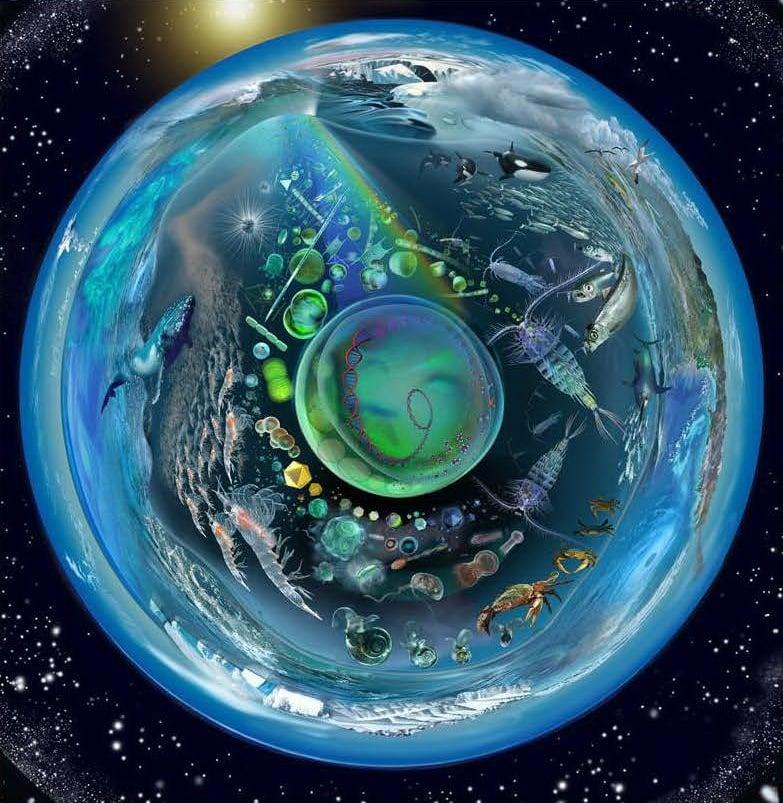Table of Contents
- Understanding Gaia Theory and Its Scientific Foundations
- Exploring the Key Components of the Gaia Theory Diagram
- Visualizing Earths Self-Regulating Systems through Gaia Theory
- Applications of Gaia Theory in Environmental Science and Climate Studies
- Practical Recommendations for Integrating Gaia Principles in Sustainability Practices
- Q&A
- To Wrap It Up
Understanding Gaia Theory and Its Scientific Foundations
The Gaia Theory, first proposed by British scientist James Lovelock in the 1970s, posits that the Earth functions as a self-regulating system. This concept suggests that biological, geological, and atmospheric components work together to maintain conditions conducive to life. At its core, the theory emphasizes the interconnectedness of all living organisms and their environment, highlighting the role each plays in sustaining the planet’s equilibrium. This self-regulation occurs through various feedback loops that help stabilize the climate and support biodiversity.
Key principles underlying Gaia Theory include:
- Homeostasis: The ability of the Earth to maintain a stable environment despite external changes.
- Feedback Mechanisms: Interactions between biotic and abiotic components that regulate elements like carbon dioxide levels and temperature.
- Biodiversity’s Role: The importance of a diverse ecosystem in ensuring resilience and adaptability to environmental shifts.
To illustrate these concepts better, consider the following table showcasing the interactions within the Gaia system:
| Component | Function | Impact on the System |
|---|---|---|
| Oceans | Regulate climate and absorb CO2 | Stabilizes temperature and supports marine life |
| Forests | Produce oxygen and store carbon | Enhances air quality and combats climate change |
| Soil Microbes | Decompose organic matter | Nutrient cycling that supports vegetation |

Exploring the Key Components of the Gaia Theory Diagram
The Gaia Theory diagram encapsulates a tapestry of relationships that illustrate the intricate balance within Earth’s systems. At its core, the diagram highlights how biological, chemical, and physical components interact, emphasizing the view that living organisms and their inorganic surroundings are part of a self-regulating complex system. Key elements include:
- Biotic Factors: These are the living components such as plants, animals, and microorganisms that interact with the abiotic environment.
- Abiotic Factors: This category includes climate, soil, water, and other non-living elements that sustain life.
- Feedback Mechanisms: Processes that create self-regulation within ecosystems, allowing for homeostasis.
In understanding the connections illustrated by the diagram, it is crucial to recognize feedback loops. Positive feedback loops enhance changes, potentially leading to rapid shifts within ecosystems, while negative feedback loops promote stability. To visualize these processes more clearly, the diagram often employs arrows and symbols to indicate interactions and the direction of influence. The following table summarizes these feedback mechanisms:
| Feedback Mechanism | Effect |
|---|---|
| Positive Feedback | Amplifies changes, possibly leading to environmental shifts |
| Negative Feedback | Mitigates changes, promoting balance and stability |
the Gaia Theory diagram underscores the significance of interconnectedness among all Earth’s systems, revealing how human actions can impact this delicate balance. By recognizing the interdependencies highlighted in the diagram, we can cultivate a deeper awareness of our role within the ecosystem. This not only fosters appreciation for our environment but also inspires action towards sustainable practices that protect our planet’s fragile equilibrium.

Visualizing Earths Self-Regulating Systems through Gaia Theory
Gaia Theory offers a fascinating framework to understand Earth as a complex, self-regulating system where living organisms interact with their inorganic surroundings to maintain conditions necessary for life. This concept not only encapsulates ecological balance but also emphasizes the synergy between various components of the Earth, such as atmosphere, oceans, and land. Visual representations can enhance our understanding of these interactions, showcasing the intricate web of relationships that sustain our planet.
One effective way to visualize these self-regulating systems is through diagrammatic representations that illustrate interconnected processes. These could include:
- Feedback Loops: Demonstrating how changes in one component lead to reactions in others, maintaining stability.
- Energy Flow Diagrams: Highlighting how energy moves between producers, consumers, and decomposers.
- Biogeochemical Cycles: Visualizing the cycles of carbon, nitrogen, and water that are vital for life.
Using interactive models or infographics can further aid in comprehending this theory. An interactive diagram, for example, can allow users to explore different systems, such as climate regulation by forests or the role of oceans in absorbing carbon dioxide. Furthermore, a well-structured table can summarize the elements of Gaia theory, including factors like:
| Component | Role in Gaia Theory |
|---|---|
| Atmosphere | Regulates temperature and gas concentrations. |
| Oceans | Absorb carbon, influence climate, and support biodiversity. |
| Biosphere | Interacts with geological and atmospheric processes to maintain life. |
Visualizing these elements allows for a holistic perspective of how natural systems interact and respond to both external and internal changes. This perspective not only deepens our understanding of ecological principles but also highlights the importance of protecting these systems to maintain the delicate balance necessary for life on Earth.

Applications of Gaia Theory in Environmental Science and Climate Studies
The Gaia Theory, which posits that the Earth functions as a self-regulating system, provides profound insights into environmental science and climate studies. By perceiving the Earth as an interconnected web of life, this theory emphasizes the importance of feedback loops in maintaining conditions suitable for life. For instance, the interplay between biotic factors (like plants and animals) and abiotic factors (such as climate and soil) can illustrate how disruptions in one element can disproportionately affect the whole system, revealing the delicate balance that sustains our planet.
In practical applications, Gaia Theory informs approaches to sustainable development and conservation efforts. This perspective encourages scientists and policymakers to consider not just isolated ecosystems but to view regional and global environmental impacts holistically. For example, integrated resource management utilizes the Gaia framework to align agricultural practices with local biodiversity and climate patterns, ensuring that land use is optimized while minimizing ecological damage. Furthermore, the concept can guide the design of resilient cities that incorporate green spaces, which not only improve urban air quality but also enhance community well-being.
The implications of Gaia Theory also extend to climate change research and mitigation strategies. Recognizing the Earth as an interconnected system reinforces the need for collaborative international efforts to address issues like greenhouse gas emissions and habitat loss. To visualize these interactions, scientists often employ models that integrate various datasets to forecast potential future scenarios under different climate strategies. The following table highlights key elements of the Gaia Theory applied to climate studies:
| Key Element | Application |
|---|---|
| Self-Regulation | Understanding natural feedback mechanisms |
| Interconnectedness | Holistic approaches in conservation |
| Biodiversity Preservation | Mitigating climate impacts through ecosystem services |
| Climate Resilience | Designing adaptive strategies for communities |

Practical Recommendations for Integrating Gaia Principles in Sustainability Practices
Integrating Gaia principles into sustainability practices demands a holistic approach that recognizes the intricate interdependencies of life systems. You can start by cultivating a systems-thinking mindset across all sectors involved in sustainability. This involves training teams to see the connections between their actions and the larger ecological system. Encourage the use of tools such as ecosystem mapping, where stakeholders can identify critical interactions and feedback loops, thus better understanding the community’s impact on natural resources.
Next, foster collaborative initiatives that unite various stakeholders within your community or organization. This can manifest as partnerships between businesses, local governments, and non-profits aimed at addressing pressing environmental issues. Encourage knowledge exchange by hosting workshops that invite subject matter experts to share their insights into successful Gaia-inspired practices. Additionally, consider establishing local action networks to facilitate ongoing communication and learning among participants, ensuring that the information shared is practical and accessible.
measure and monitor the outcomes of the initiatives grounded in Gaia principles. Use frameworks that emphasize not just economic gains, but also social and environmental well-being. For instance, create a triple bottom line report that encompasses economic, social, and ecological dimensions of success. Below is an example of how to structure such a report:
| Dimension | Metrics | Results |
|---|---|---|
| Economic | Cost savings, revenue growth | 15% reduction in costs |
| Social | Community engagement, job creation | Increased volunteer participation |
| Ecological | Biodiversity improvements, resource conservation | 10% increase in local species |
Q&A
Q&A: Understanding the Gaia Theory Diagram
Q1: What is the Gaia Theory? A: The Gaia Theory, proposed by James Lovelock in the 1970s, suggests that Earth functions as a self-regulating system. It posits that the biosphere, atmosphere, hydrosphere, and geosphere interact in complex ways to maintain the conditions necessary for life. Essentially, it views the planet as a single living organism, where life itself contributes to the stability of its environment.Q2: What does a Gaia Theory diagram typically illustrate? A: A Gaia Theory diagram usually illustrates the interconnectedness of various Earth systems and how they work together to support life. It often includes representations of the atmosphere, oceans, soils, and living organisms, showcasing feedback loops and processes that regulate temperatures, gases, and nutrient cycles. This visual representation helps to highlight how changes in one part of the system can impact the whole.
Q3: Why is the Gaia Theory diagram important for understanding ecological relationships? A: The Gaia Theory diagram is crucial for holistic ecological understanding as it encapsulates complex interactions in a simplified manner. By visualizing these relationships, we can better comprehend how human actions, such as pollution or deforestation, can disrupt these delicate balances, influencing climate, species survival, and overall planetary health. It serves as a reminder of our interconnectedness with the environment.
Q4: Can you explain the key elements typically represented in a Gaia Theory diagram? A: Key elements in a Gaia Theory diagram often include:
- Biosphere: All living organisms and their habitats.
- Atmosphere: The layer of gases surrounding Earth that supports life.
- Hydrosphere: Earth’s water bodies, influencing weather patterns and life.
- Geosphere: The solid Earth, including rocks, soil, and landforms.
Q5: How can the Gaia Theory inspire sustainable practices? A: By emphasizing the interdependence of life and environmental systems, the Gaia Theory encourages a more respectful and sustainable approach to how we interact with our planet. Understanding that our actions can have far-reaching consequences can inspire individuals and policymakers to adopt practices that support ecological balance, such as reducing waste, conserving biodiversity, and implementing renewable energy solutions.
Q6: Is there any criticism of the Gaia Theory? A: Yes, while the Gaia Theory has been influential in ecological thought, it has faced criticism. Some scientists argue that describing Earth as a self-regulating superorganism oversimplifies complex ecological dynamics and can detract from the importance of understanding species-specific behaviors and interactions. Debates continue in the scientific community regarding the implications and accuracy of viewing Earth as a single living entity.
Q7: Where can I find more information or resources on Gaia Theory? A: A wealth of information regarding the Gaia Theory can be found in books by James Lovelock, academic journals focused on ecology and environmental science, and trusted online resources such as educational websites and documentaries that delve into Gaia Theory and its implications for understanding our planet’s ecosystems.These resources can enrich your understanding and provide deeper insights into the relevance of Gaia Theory in contemporary environmental discussions.



0 Comments